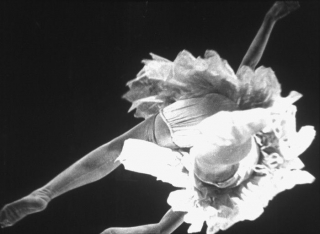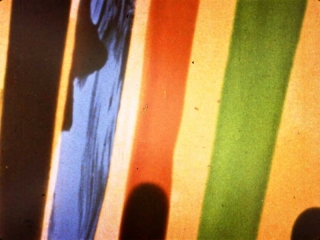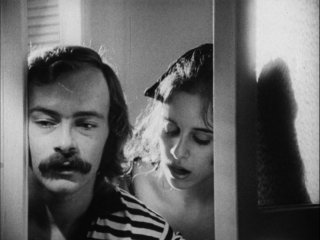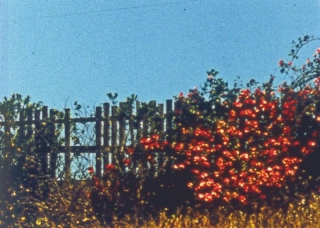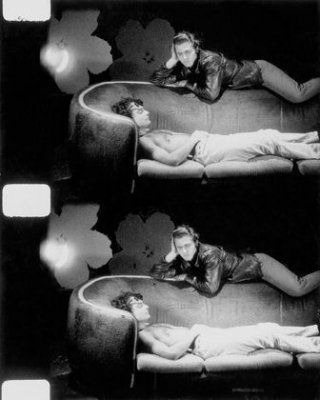Date: 2 October 1999 | Season: Dublin Fringe Festival 1999
IN DREAMS: SURREALISM AND TRANCE FILMS
Saturday 2 October 1999, at 1:10pm
Dublin Irish Film Centre
René Clair, Entr’acte, France, 1924, 23 min
Entr’acte, one of the first avant-garde films, was originally made as an interlude to a ballet by Erik Satie. Using a variety of innovative camera tricks, René Clair developed new techniques to illustrate the Dada script by artist Francis Picabia. Free of logic, the film depicts an absurd chase after a runaway hearse.
Maya Deren, Meshes of the Afternoon, USA, 1943,18 min
The making of Maya Deren’s first film was a key point in the advancement of the personal film. It is one of the earliest ‘trance’ films, a style which developed from the earlier European Surrealist films of the 1920s and 30s. Deren creates a subconscious world and portrays a dreamer disturbed by a series of irrational incidents.
Kenneth Anger, Fireworks, USA, 1947, 14 min
Anger made this homosexual psychodrama at the age of 17, using old navy film stock, one weekend while his parents were away from home. It follows a wandering adolescent “drawn through the needle’s eye” of a nightmare dream.
Sidney Peterson, The Lead Shoes, USA, 1949, 15 min
Amid images distorted by anamorphic lenses, mother tries to rescue her son, who is dead in a diving suit. On the fragmented soundtrack a loose jazz group improvises and mixes up two traditional ballads. Sidney Peterson was at the vanguard of the American avant-garde film wave.
Stan Brakhage, Reflections on Black, USA, 1955, 12 min
Stan Brakhage is regarded by many as the master of experimental cinema. In Reflections on Black, the visions of a blind man depict an erotic and aesthetic quest, which transcends the distinction between fantasy and reality. This angst-ridden drama of relationships in a New York tenement building is an early example of Brakhage’s rejection of sound, which he believes interferes with the purity and clarity of vision.
Back to top
Date: 2 October 1999 | Season: Dublin Fringe Festival 1999
FREEING THE IMAGE: ANIMATION AND ABSTRACTION
Saturday 2 October 1999, at 3pm
Dublin Irish Film Centre
Rhythmus 21, Hans Richter, 1921, 3 min
In his first film, the artist Hans Richter reduced the image to the rectangle, the most basic form, which he uses to subvert the cinematic illusion of depth.
Alexandre Alexeieff & Claire Parker, Night on the Bare Mountain, France, 1934, 6 min
In the 1930s, Alexeieff and Parker developed the pin screen to produce highly original and outstanding animations. 50,000 movable pins were raised and lowered by hand to create light and shade, then photographed in single frame stop motion.
Oskar Fischinger, Komposition in Blau, Germany, 1935, 4 min
Using paper cut-outs and three dimensional objects, Fischinger created one of his most complex films. These inanimate objects march and dance in tight synchronisation to the music of Nicolai.
Norman McLaren, Boogie-Doodle, Canada, 1940, 4 min
A piano boogie by Albert Ammons in interpreted by the prolific Scottish animator Norman McLaren, who made films for both the British GPO Film Unit and the National Film Board of Canada.
Shirley Clarke, Bridges Go Round, USA, 1958, 8 min
Shots of immobile New York bridges are choreographically edited and printed in a way such that they appear to dance. The footage is repeated twice, once with a score by jazz arranger Teo Macero and again with a composition by electronic music pioneers Louis and Bebe Barron (best known for their soundtrack to The Forbidden Planet).
Ian Hugo, Bells of Atlantis, USA, 1952, 10 min
An impressionist cine-poem providing visual accompaniment to “The House of Incest”, which is read by its author Anaïs Nin. The magical fusion of image, text and sound vividly depicts the sunken city of the subconscious. Produced with technical assistance from Len Lye and an electronic soundtrack by the Barrons.
Hy Hirsh, Come Closer, USA, 1952, 5 min
The mysterious Hy Hirsh made a handful of freewheeling abstract compositions throughout the 1950s. Films such as Come Closer were the first to combine electronic imagery from oscilloscopes with photographed or animated footage.
Len Lye, A Colour Box, UK, 1935, 4 min
Master animator Len Lye made several innovative short films for John Grierson’s GPO Film Unit before moving to the US, slowly withdrawing from film to concentrate on making large-scale kinetic sculptures. A Colour Box is contains vibrant imagery painted directly onto the film and accompanies a lively number by Don Barretto and his Cuban Orchestra.
Peter Kubelka, Schwechater, Austria, 1958, 2 min
Originally commissioned as a beer commercial, Schwechater shows young people drinking in a café. The four brief shots which make up the film are metrically edited in a harsh, repetitive manner according to a stylised set of rules to provide a short but intense visual experience.
Harry Smith, No. 7 (Color Study), USA, 1951, 4 min
Legendary alchemist and anthropologist Harry Smith made a series of wonderful animated works. Early Abstractions: No. 7 consists of optically printed Pythagorean shapes made under the influence of cocaine and ups. (Harry Smith had a lifelong voracious appetite for all kinds of stimulants.) Smith’s films work best with jazz and bebop soundtracks, but this print is accompanied by a Beatles song.
James Whitney, Lapis, USA, 1963-66, 9 min
James Whitney, one of the pioneers of computer animation, presents a constantly evolving mandala image as a highly psychedelic meditation tool.
Larry Jordan, Duo Concertantes, USA, 1964, 9 min
Larry Jordan became known for constructing exquisite animations from surreal Victorian engravings. This procedure generates radical juxtapositions of scale, spatial relationships and the associative qualities of objects. Rococo imagery mixes with space age symbols as a mystical lady with an orbital head moves through the carnival of life.
Paul Sharits, Piece Mandala / End War, USA, 1966, 3 min
Paul Sharits produced a series of outstanding ‘flicker’ films in which rapid changes of colour result in perceptual hallucinations. Piece Mandala / End War is a concise and remarkable example of his stroboscopic style.
Robert Breer, 69, USA, 1968, 5 min
Robert Breer, whose films present continually evolving ideas in a witty, gentle style, is one of the most original and respected animators of the experimental movement. 69 is a kinetic investigation of geometric forms, building visual tension by rapidly alternating images.
Scott Bartlett, Offon, USA, 1968, 9 min
Scott Bartlett was one of the first filmmakers to utilise the newly developed video technology in his work. Offon evolved in an audio-visual jam session and is a virtuoso display of image and sound processing.
Tony & Beverly Conrad, Straight and Narrow, USA, 1970, 10 min
After making The Flicker which consists solely of alternating black and white frames, the composer Tony Conrad collaborated with his wife Beverly on Straight and Narrow. Accompanied by psychotic music from John Cale and Terry Riley, rapidly changing horizontal and vertical lines produce visual hallucinations of colour and complex patterns.
Back to top
Date: 2 October 1999 | Season: Dublin Fringe Festival 1999
THUNDERCRACK!
Saturday 2 October 1999, at 6:30pm
Dublin Irish Film Centre
Curt McDowell, Thundercrack!, USA, 1975, 158 min
Starring George Kuchar, Marion Eaton and Melinda McDowell
It reads like any classic horror story – a group of teenagers break down in the woods and are forced to spend the stormy night in an eerie, dark house – but from the outset it is clear that this is no ordinary movie, and by the time the sexually active gorilla appears, the audience is clearly in uncharted, perhaps unwanted, territory. This legendary cult film combines George Kuchar’s incredible sense of melodrama with sequences of hard-core sexual fantasy to make the underground’s only pornographic horror blockbuster. Legend tells that Kuchar wrote the script while high on LSD during a thunderstorm in Nebraska, but with true Kucharian pathos it was actually written during a stay at the YMCA in Oklahoma. The film’s director, Curt McDowell, was George Kuchar’s first student at the San Francisco Art Institute, where he still teaches to this day. Having already become a legendary figure in the New York underground film movement, known for classics like Hold Me While I’m Naked and Eclipse of the Sun Virgin, Kuchar moved out to California in 1971 and accepted the teaching post offered to him by filmmaker Larry Jordan. In 1973, McDowell starred in Kuchar’s epic The Devil’s Cleavage, and to return the favour to his favourite student, George wrote, did the lighting and make-up and played a leading role in Thundercrack!. The film was produced by two other students, John and Charles Thomas, partial heirs to the Burger King fortune.
Marion Eaton plays Gert Hammond, sole occupant of the decrepit “Prairie Blossom” mansion house, whose only friend is the bottle since her husband Charlie was devoured by locusts. His remains are kept pickled in the basement, while their sexually deviant son, recently returned from Borneo and suffering from elephantitis of the scrotum, is kept locked in a secret room. On this particular dark and stormy night Gert plays hostess to two sets of strangers – a group of youngsters seek shelter and wind up confronting their own peculiar sexual demons, and later George Kuchar enters as “Bing”, a carnival gorilla keeper who has survived a suicidal attempt to crash his truck. Kuchar’s overwrought melodramatic dialogue which drives the film makes it quite unlike any other movie in the old dark house genre.
While it gained several good reviews on its release, even in staid publications like Britain’s Sight And Sound, Thundercrack! is perhaps just too far out to gain the box office success achieved by similarly trashy features by John Waters, or even Ed Wood. It was a success on the American midnight movie circuit of the late 1970s, but since then has only rarely been seen in cinemas. Only four prints, each of varying lengths, survive and the one presented tonight is the complete 158 minute version. Pushing 3 hours, many people regard the film as an ordeal or endurance test, but sit back and relax (it’s one minute shorter than Eyes Wide Shut!) and enjoy a true, unadulterated Cult Movie. McDowell, Kuchar and leading lady Marion Eaton were reunited for the long and troubled production Sparkle’s Tavern, a less explicit but equally vulgar and deranged film, which took eight years to complete between 1976 and 1984.
Please Note: Thundercrack! is suitable only for mature adult audiences and contains scenes that some people may find offensive.
Back to top
Date: 3 October 1999 | Season: Dublin Fringe Festival 1999
GOING UNDERGROUND: THE NEW AVANT-GARDE
Sunday 3 October 1999, at 1:10 pm
Dublin Irish Film Centre
Bruce Conner, A Movie, USA, 1958, 12 min
Assemblage artist Bruce Conner conceived his first film as a loop forming part of a sculpture. A Movie edits together material from various sources to suggest a continuity where one cannot plausibly exist. Widely regarded as one of the masters of experimental cinema, and a direct influence on TV commercials and pop videos, Conner rarely shoots his own material, preferring to montage found or stock footage.
Robert Nelson, Oh Dem Watermelons, USA, 1965, 12 min
A classic underground romp starring the San Francisco Mime Troop and a dozen watermelons. The fruit is put through every possible use and treatment for comic effect and social comment. Minimalist composer Steve Reich arranged the soundtrack.
Ken Jacobs, Little Stabs at Happiness, USA, 1959-63, 15 min
Little Stabs at Happiness consists of several unedited camera poems which depict a wistful nostalgia for times passed. Two sections feature the legendary filmmaker and performer Jack Smith. Ken Jacobs went on to be an important influence on the Structural movement and since the 1970s has developed amazing 3D projection performances known as the Nervous System.
Joyce Wieland, 1933, Canada, 1967, 5 min
Canadian filmmaker Joyce Wieland was one of the pioneers of the Structural film movement. 1933 is a formal fixed view from a window above a street. Harsh and playful, the film has such a timeless quality it looks as though it could have been made over a hundred years ago.
Michael Snow, Standard Time, Canada, 1967, 8 min
Made as a study for <—>, a film that uses an unrelenting ‘back and forth’ pan to further investigate space in the style of his continuous zoom in Wavelength. For Standard Time the camera roams freely around a small room before settling on an unexpected subject.
Jonas Mekas, Award Presentation to Andy Warhol, USA, 1964, 12 min
Mekas, the irrepressible force behind the promotion and preservation of experimental film, is also known for his rapid-fire diary films. Award Presentation to Andy Warhol documents Mekas giving Warhol (and Factory superstars Gerard Malanga, Baby Jane Holzer and Ivy Nicholson) the Film Culture Sixth Independent Film Award. In contrast to his regular shooting style, Mekas, assisted here by Gregory Markopoulos, uses one long take to replicate Warhol’s own techniques.
George Kuchar, Hold Me While I’m Naked, USA, 1966, 15 min
The Kuchar Brothers’ films are no-budget homages to Hollywood, which depict their own mundane lives as glamorous Technicolor dramas. Hold Me While I’m Naked is a hilarious parody of the frustration and loneliness of a Bronx filmmaker who thinks everyone is having a more exciting, sexier time than he.
Anthony Balch, Towers Open Fire, UK, 1963, 10 min
Towers Open Fire is the most accomplished collaboration between Balch and author William Burroughs. Loosely based on the novel “The Nova Express”, it uses film to illustrate the cut-up writing process.
Owen Land (formerly known as George Landow), New Improved Institutional Quality, USA, 1976, 10 min
Land’s films often use humour and formal technique to question the relationship between the filmmaker, the film and the audience. New Improved Institutional Quality is an absurd IQ test which mocks the illusions of cinema by disregarding senses of scale and rational conception.
Bruce Baillie, All My Life, USA, 1966, 3 min
A single pan across a white picket fence on a clear summer’s day is accompanied by the Billie Holliday song. All My Life is a perfect film which condenses a complete statement in a single shot.
Back to top
Date: 3 October 1999 | Season: Dublin Fringe Festival 1999
FLAMING CREATURES / COUCH
Sunday 3 October 1999, at 3:00pm
Dublin Irish Film Centre
Jack Smith, Flaming Creatures, USA, 1962-63, 45 min
Starring Mario Montez, Francis Francine and Sheila Bick.
For many people the words “Underground Film” invoke ideas of sexual depravity and cinematic obscenities, but Flaming Creatures and similar films do not use nudity to titillate, rather to express an innocent freedom, showing new ways of uninhibited personal expression. Jack Smith’s most celebrated flick, and the court proceedings which followed its release, went some way to liberate cinema, breaking down the moral barriers and censorship so that previously taboo subjects could be presented on film.
Flaming Creatures‘ unique style is due to Smith’s Baghdadian visions and his worship of B-movie actress Maria Montez (reincarnated here by transvestite star Mario Montez). After an unreasonably long credit sequence, we hear the invocation “Ali Baba Comes Today!” and receive our first glimpse at the nonchalant limp penises and fondled breasts the film became inadvertently notorious for. There is a mocking advert for heart shaped indelible lipstick, and an earthquake orgy sequence in which the partially robed Superstars of Cinemaroc pose in a series of outlandish tableaux. Dance segments are punctuated by placid, abstract cutaways of materials and painted backdrops. The soundtrack is a meticulously constructed mix of opera, exotica and seemingly banal popular music such as the Everly Brothers’ “Be-Bop-A-Lu-La”. The film achieves its timeless and otherworldly washed-out look due to being shot on outdated black and white film stock and remains a unique masterpiece.
Andy Warhol, Couch, USA, 1964, 51 min
Starring Gerard Malanga, Piero Heliczer, Naomi Levine, Gregory Corso, Allen Ginsberg, John Palmer, Baby Jane Holzer, Ivy Nicholson, Ondine, Peter Orlovski, Jack Kerouac, Taylor Mead, Billy Name and others.
Using Warhol’s early cinematic style of a fixed camera and long take, Couch is an episodic film depicting a succession of visitors engaged in various types of social and sexual intercourse on the Factory sofa. It is truly voyeuristic, with the camera passively staring at the activities. Each individual three minute roll of film comprises of a single shot filmed at 24 frames per second and projected at 16 or 18 fps, effectively slowing down real time. In presenting homosexuality as just one act in a series of normal sexual practises, Warhol makes a subtle attempt at breaking down erotic taboos.
Warhol’s film career evolved in four distinct phases. This first period of silent sequences using minimal composition and a fixed camera view lasted only eighteen months but produced some of his most notorious works such as Sleep, Eat and Empire. Couch came towards the end of this phase, which culminated in the purchase of an Auricon sync sound camera. Using his rapidly growing stable of Factory Superstars to portray scenarios by Theatre of The Absurd veteran Ronald Tavel, Warhol embarked on a series of star vehicles like Vinyl, Hedy and The Life of Juanita Castro featuring Mario Montez, Edie Sedgwick, Gerard Malanga and others. A third phase began with My Hustler and the arrival of Paul Morrissey at the Factory. The films now began to tend towards exploitation and started to become more traditional in narrative form. After the box office success of the innovative double screen epic The Chelsea Girls, the financial potential of filmmaking became apparent. A new wave of superstars including Viva, Ingrid Superstar and Louis Walden took lead roles in Bike Boy, Nude Restaurant and Lonesome Cowboys. Following the assassination attempt on Warhol by Valerie Solanis in 1968, Paul Morrissey took over the Factory Films operation and achieved critical and commercial success with the Flesh, Trash and Heat trilogy starring Joe Dallesandro. Warhol’s filmmaking activities wound down in the mid-1970s after he co-produced Dracula and Frankenstein.
Please Note: These films are suitable only for mature adult audiences and contains scenes that some people may find offensive.
Back to top
